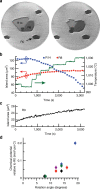Real-time observation of epitaxial graphene domain reorientation
- PMID: 25892219
- PMCID: PMC4411305
- DOI: 10.1038/ncomms7880
Real-time observation of epitaxial graphene domain reorientation
Abstract
Graphene films grown by vapour deposition tend to be polycrystalline due to the nucleation and growth of islands with different in-plane orientations. Here, using low-energy electron microscopy, we find that micron-sized graphene islands on Ir(111) rotate to a preferred orientation during thermal annealing. We observe three alignment mechanisms: the simultaneous growth of aligned domains and dissolution of rotated domains, that is, 'ripening'; domain boundary motion within islands; and continuous lattice rotation of entire domains. By measuring the relative growth velocity of domains during ripening, we estimate that the driving force for alignment is on the order of 0.1 meV per C atom and increases with rotation angle. A simple model of the orientation-dependent energy associated with the moiré corrugation of the graphene sheet due to local variations in the graphene-substrate interaction reproduces the results. This work suggests new strategies for improving the van der Waals epitaxy of 2D materials.
Figures




References
-
- Yu Q. et al.. Control and characterization of individual grains and grain boundaries in graphene grown by chemical vapor deposition. Nat. Mater. 10, 443–449 (2011). - PubMed
-
- Nie S., Wofford J. M., Bartelt N. C., Dubon O. D. & McCarty K. F. Origin of the mosaicity in graphene grown on Cu(111). Phys. Rev. B 84, 155425 (2011).
-
- Nie S. et al.. Scanning tunneling microscopy study of graphene on Au(111): growth mechanisms and substrate interactions. Phys. Rev. B 85, 205406 (2012).
-
- Loginova E., Nie S., Thürmer K., Bartelt N. C. & McCarty K. F. Defects of graphene on Ir(111): rotational variants and ridges. Phys. Rev. B 80, 085430 (2009).
-
- van der Zande A. M. et al.. Grains and grain boundaries in highly crystalline monolayer molybdenum disulphide. Nat. Mater. 12, 554–561 (2013). - PubMed
Publication types
LinkOut - more resources
Full Text Sources
Other Literature Sources

